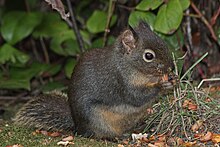Trout Creek Hill
Trout Creek Hill produced a lava flow about 340,000 years ago that traveled 20 km (12 mi) southeast, which dammed the Columbia River for a short period of time.
To reach Trout Creek Hill, visitors should travel north on the Wind River highway and follow Forest Service road 54.
Other forest floor plants include the brackenfern, prince's pine, swordfern, trillium, twinflower, queencup beadlily, and vanilla leaf, with beargrass and huckleberry at higher elevations.
[8] In the Wind River area, the Cascades sit atop Cenozoic era lava flows and volcaniclastic deposits, which have a calc-alkaline composition.
Activity picked up during the Quaternary period in Washington, as andesitic stratovolcanoes and small, olivine basalt cinder cones and shield volcanoes erupted.
Like Red Mountain, a shield volcano with cinder cones, Trout Creek Hill formed west of the Wind River area.
[11] Rocks in the Wind River area have not been altered significantly by orogenic movement (large structural deformation of the Earth's crust and uppermost mantle due to the interaction between plate tectonics).
[17] Trout Creek Hill erupted approximately 340,000 years ago during the Pleistocene, producing a lava flow that extended 12 miles (20 km) to the southeast and temporarily dammed the Columbia River.
[16] Other lava flows from Trout Creek Hill are also embedded with till from Salmon Springs and Fraser Glaciation, but their exact age is unknown.
[20] Basaltic lavas from Trout Creek Hill show a lithology of pāhoehoe to blocky olivine, with pyroxene, breccia, scoria, and cinder deposits.
The Pacific Crest National Scenic Trail #2000 can be hiked, moving through the Trout Creek division of Wind River Forest.
[22] Sedum Point, located along part of the Pacific Crest Trail, offers views of the Trout Creek Hill volcano.

